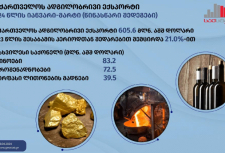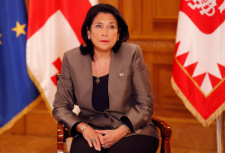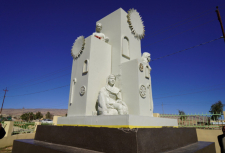Excerpts from the report - Human rights situation of the Yazidi minority in Transcaucasia

(Armenia, Georgia, Azerbaijan)
Yazidi community in Armenia
*Report commissioned by the United Nations High Commissioner for Refugees: refworld.org
Armenia has always been the most ethnically homogeneous of the Soviet republics, and the only significant minority in Armenia is the Yazidi community. According to the 2002 census, 97.7% of the total population of the republic were ethnic Armenians. Even though Armenia avoids the image of a state with significant problems in the field of human rights, its reputation in this region has been mixed since independence.
Armenia is a State party to the main international human rights treaties, including the International Covenant on Civil and Political Rights (ICCPR), the International Covenant on Economic, Social and Cultural Rights (ICESCR), the European Convention on Human Rights (ECHR), the Framework Convention for the Protection of National Minorities (FCNM), the International Convention on the Elimination of All Forms of Racial Discrimination (CERD), the European Charter for Regional or Minority Languages and the (revised) Convention for the Protection of National Minorities).
Article 14 of the Armenian Constitution prohibits any discrimination based on” race, color, ethnic origin, language, religion, or membership of a national minority". Article 26 provides for freedom of conscience or belief, and article 41 grants the right “to preserve national and ethnic identity. Persons belonging to national minorities have the right to preserve and develop their traditions, religion, language, and culture”
The main institutions dealing with the issues of minority rights in Armenia are the Office of the Human Rights Defender (Ombudsman), the Steering Committee on National Minorities under the President. The Council for National Minorities under the National Assembly, the Coordinating Council for Ethnic Minorities, and the Department for National Minorities and Religions. In its 2006 report, the Office of the Human Rights Defender reported that it had received several complaints from members of national minorities, and those that had been received related to general human rights violations not related to issues of ethnicity or discrimination. The Department for National Minorities and Religions was established in 2004 and is engaged in information, education and research activities related to minorities, as well as the development of a draft law "On national minorities". One of the areas of his work was the educational situation for the Yezidi, Kurdish and Molokan minorities in rural areas of Armenia.
The second ECRI report on Armenia notes that representatives of minorities feel excluded from political representation, deprived of any seats in the National Assembly or significant positions in the government. Although the Armenian authorities have reportedly allocated a budget of 9 million Armenian drams (approximately US $ 28,000) to promote minority culture, minority organizations have expressed concern that they are under-funded; This situation is particularly serious for those minorities who do not have an external sister State to provide an alternative source of resources.
Yazidis in Armenia are in an unusual situation, they are the largest national minority in the country. The Yezidi population of Armenia lives mainly in rural areas, mainly engaged in animal husbandry.
The Yazidi minority in Armenia is characterized by a much higher degree of politicization of its identity than anywhere else in the region, leading to an often-heated debate among community leaders in Yerevan who do little to address the very real socio-economic problems facing the wider Yazidi population. Although Armenia is widely regarded as one of the very few states in the world that is tolerant of its Yazidi/Kurdish population, this obscures a more complex picture. While the Yazidis maintained a relatively stable community life in post-Soviet Armenia, problems of social exclusion, problems with land and property privatization, legal disputes over land, water and pasture disputes, lack of political representation and protection under the law, as well as the destructive aggravation of the border between the Yazidi and Kurdish identities were widely reported.
Since the late 1980s, the Yazidi community in Armenia has made attempts to finally separate the concepts of Yazidi ethnic identity from the Kurdish one. This trend was reportedly encouraged by the Armenian authorities, and in May 2001 the National Assembly adopted a resolution recognizing the Yazidi language as a separate language. In the 2001 census in Armenia, Yazidis were able to identify themselves as Yazidis rather than Kurds. Following the outrage of a faction of the Yazidi community that proposed to ratify the Kurdish language of Kurmanji as the language spoken by Yazidis in Armenia, the government ratified both "Yazidi” and” Kurdish" in accordance with the European Charter for Regional and Minority Languages. This is due to the prevailing attitudes in the region, largely inherited from the Russian imperial and Soviet authorities, that language is the main marker of national identity. In this context, providing a separate status for a speech form that was previously considered a dialect lends considerable legitimacy to the claims of a separate identity.
There are many Yazidi cultural associations in Armenia, as well as some Kurdish associations. Yazidis in the villages of Armenia lost out in the process of land privatization, many were left without property rights or the necessary access to pastureland. Although opinions differ as to the extent to which this can be attributed to discrimination, the very fact that it is a national minority that has been disadvantaged has given rise to claims of discrimination.
The Armenian authorities claim that no applications for the privatized land plots were received from the Yazidis. In 2000, a new law was passed providing for the privatization of land by auction. While some observers considered this arrangement unprofitable for the relatively poor Yazidi community, government officials suggested that the Yazidis lost the land auctions because community representatives did not attend the auction despite warning. In any case, the outcome of the lost auctions created tension between the Yazidi community and the Armenians.
The ECRI also filed claims that instead of good land, the Yazidis received wastelands or unusable land in the mountains. The mixed Yazidi-Armenian village of Zovuni is a good example. In the early 2000s, residents of the village of Zovuni began to complain that, unlike their Armenian neighbors, they did not receive their land certificates, despite the privatization process that began in 1991. Government officials claimed that the Yazidis did not submit their applications on time or properly.
Yazidi community leaders claimed that they were not informed of the auction sale until after it was over. Yazidis were also reportedly subjected to xenophobic insults from those who bought land. In 2005, a complaint was filed with the Office of Human Rights Defenders on behalf of 250 Yazidis from the village, although the complaint is apparently still pending. The residents of Zovuni village and their neighbors in Avo village were also concerned about the poor irrigation, gas and sewer equipment in the village, highlighting the steady process of depopulation and herd decline as a consequence of socio-economic deprivation. Yazidis from Zovuni also expressed concern about hidden discrimination in light of the authorities ' failure to remove dangerously dilapidated electricity poles from the village and the inability of three Yazidi candidates to be elected in local council elections. Repeated promises by the authorities to help improve the situation have reportedly not led to change.
Overall, it seems that the Yazidis have been sidelined by the privatization process, and disputes over land use have soured Yazidi-Armenian relations in some areas. Although Armenian officials insist that they followed the law by notifying the Yazidis of upcoming auctions and so on, communication failures between the authorities and the community led to the latter losing. This has had a major impact on the economic sustainability of the Yazidi community. It also had a side effect when disputes led to crimes against Yazidis that were reportedly not properly investigated by the police.
Education and access to the school system in Armenia among Yazidis have been a source of concern for a few reasons. Yazidis, like other minorities in Armenia, work seasonally, depending on the agricultural calendar; in these circumstances, parents often prefer work over education. Therefore, children in Yazidi communities usually finish the school year in April to move with their parents to summer pastures in the highlands. Teachers in rural communities are often farmers themselves and have little interest in recording low attendance rates, so the real scale of the problem is almost certainly underestimated.
The lack of textbooks in minority languages was also highlighted as creating communication problems between young Yazidi students who do not speak Armenian and Armenian teachers. Yazidi children usually take two to three years to learn Armenian; teaching other subjects in Armenian before that time hinders their development. Although there are some Yazidi teachers, if they are not from the same village, there are reports of transport problems during the winter months. Yazidis living in mixed Yazidi-Armenian villages tend to attend Armenian schools and therefore have no education in the Kurmanji language. Attendance rates among Yazidi children are below average, and a study conducted by UNICEF in 2001 found that dropout rates were above average among national minorities, including Yazidis.
The availability of Yazidi textbooks, the number of classes available to Yazidis, the harassment of Yazidi children in the classroom, the establishment of correctional classes for Yazidi children leaving school in April, the education of Yazidi teachers, and the premature departure of Yazidi children from school were all concerns of ECRI in 2006. The Armenian authorities have tried to solve some of these problems, for example by offering remedial classes for children working on pastures in the summer, and by providing easier access to teacher training schools for Yazidi teachers. However, the Yazidis apparently did not take advantage of these measures, and communication between the authorities and the community was less than consistent.
The issues of language rights and the provision of textbooks in minority languages were further overshadowed by the controversial nature of the Yazidi identity. The conflicting views have led to concrete policy outcomes that prevent the Government from providing basic educational materials to the Yazidi communities. New textbooks were distributed in September 2006, but a few Yazidi villages were denied these textbooks, due to the publication in the Latin alphabet.
About higher education, the Armenian legislation does not specify how a member of a minority can take the entrance exams for higher education in a language other than Armenian…
To be continued…
Tags: #yazidisinfo #newsyazidi #aboutyazidi #ezidi #yazidiofcaucasus #yazidiarmenia
Excerpts from the report - Human rights situation of the Yazidi minority in Transcaucasia

(Armenia, Georgia, Azerbaijan)
Yazidi community in Armenia
*Report commissioned by the United Nations High Commissioner for Refugees: refworld.org
Armenia has always been the most ethnically homogeneous of the Soviet republics, and the only significant minority in Armenia is the Yazidi community. According to the 2002 census, 97.7% of the total population of the republic were ethnic Armenians. Even though Armenia avoids the image of a state with significant problems in the field of human rights, its reputation in this region has been mixed since independence.
Armenia is a State party to the main international human rights treaties, including the International Covenant on Civil and Political Rights (ICCPR), the International Covenant on Economic, Social and Cultural Rights (ICESCR), the European Convention on Human Rights (ECHR), the Framework Convention for the Protection of National Minorities (FCNM), the International Convention on the Elimination of All Forms of Racial Discrimination (CERD), the European Charter for Regional or Minority Languages and the (revised) Convention for the Protection of National Minorities).
Article 14 of the Armenian Constitution prohibits any discrimination based on” race, color, ethnic origin, language, religion, or membership of a national minority". Article 26 provides for freedom of conscience or belief, and article 41 grants the right “to preserve national and ethnic identity. Persons belonging to national minorities have the right to preserve and develop their traditions, religion, language, and culture”
The main institutions dealing with the issues of minority rights in Armenia are the Office of the Human Rights Defender (Ombudsman), the Steering Committee on National Minorities under the President. The Council for National Minorities under the National Assembly, the Coordinating Council for Ethnic Minorities, and the Department for National Minorities and Religions. In its 2006 report, the Office of the Human Rights Defender reported that it had received several complaints from members of national minorities, and those that had been received related to general human rights violations not related to issues of ethnicity or discrimination. The Department for National Minorities and Religions was established in 2004 and is engaged in information, education and research activities related to minorities, as well as the development of a draft law "On national minorities". One of the areas of his work was the educational situation for the Yezidi, Kurdish and Molokan minorities in rural areas of Armenia.
The second ECRI report on Armenia notes that representatives of minorities feel excluded from political representation, deprived of any seats in the National Assembly or significant positions in the government. Although the Armenian authorities have reportedly allocated a budget of 9 million Armenian drams (approximately US $ 28,000) to promote minority culture, minority organizations have expressed concern that they are under-funded; This situation is particularly serious for those minorities who do not have an external sister State to provide an alternative source of resources.
Yazidis in Armenia are in an unusual situation, they are the largest national minority in the country. The Yezidi population of Armenia lives mainly in rural areas, mainly engaged in animal husbandry.
The Yazidi minority in Armenia is characterized by a much higher degree of politicization of its identity than anywhere else in the region, leading to an often-heated debate among community leaders in Yerevan who do little to address the very real socio-economic problems facing the wider Yazidi population. Although Armenia is widely regarded as one of the very few states in the world that is tolerant of its Yazidi/Kurdish population, this obscures a more complex picture. While the Yazidis maintained a relatively stable community life in post-Soviet Armenia, problems of social exclusion, problems with land and property privatization, legal disputes over land, water and pasture disputes, lack of political representation and protection under the law, as well as the destructive aggravation of the border between the Yazidi and Kurdish identities were widely reported.
Since the late 1980s, the Yazidi community in Armenia has made attempts to finally separate the concepts of Yazidi ethnic identity from the Kurdish one. This trend was reportedly encouraged by the Armenian authorities, and in May 2001 the National Assembly adopted a resolution recognizing the Yazidi language as a separate language. In the 2001 census in Armenia, Yazidis were able to identify themselves as Yazidis rather than Kurds. Following the outrage of a faction of the Yazidi community that proposed to ratify the Kurdish language of Kurmanji as the language spoken by Yazidis in Armenia, the government ratified both "Yazidi” and” Kurdish" in accordance with the European Charter for Regional and Minority Languages. This is due to the prevailing attitudes in the region, largely inherited from the Russian imperial and Soviet authorities, that language is the main marker of national identity. In this context, providing a separate status for a speech form that was previously considered a dialect lends considerable legitimacy to the claims of a separate identity.
There are many Yazidi cultural associations in Armenia, as well as some Kurdish associations. Yazidis in the villages of Armenia lost out in the process of land privatization, many were left without property rights or the necessary access to pastureland. Although opinions differ as to the extent to which this can be attributed to discrimination, the very fact that it is a national minority that has been disadvantaged has given rise to claims of discrimination.
The Armenian authorities claim that no applications for the privatized land plots were received from the Yazidis. In 2000, a new law was passed providing for the privatization of land by auction. While some observers considered this arrangement unprofitable for the relatively poor Yazidi community, government officials suggested that the Yazidis lost the land auctions because community representatives did not attend the auction despite warning. In any case, the outcome of the lost auctions created tension between the Yazidi community and the Armenians.
The ECRI also filed claims that instead of good land, the Yazidis received wastelands or unusable land in the mountains. The mixed Yazidi-Armenian village of Zovuni is a good example. In the early 2000s, residents of the village of Zovuni began to complain that, unlike their Armenian neighbors, they did not receive their land certificates, despite the privatization process that began in 1991. Government officials claimed that the Yazidis did not submit their applications on time or properly.
Yazidi community leaders claimed that they were not informed of the auction sale until after it was over. Yazidis were also reportedly subjected to xenophobic insults from those who bought land. In 2005, a complaint was filed with the Office of Human Rights Defenders on behalf of 250 Yazidis from the village, although the complaint is apparently still pending. The residents of Zovuni village and their neighbors in Avo village were also concerned about the poor irrigation, gas and sewer equipment in the village, highlighting the steady process of depopulation and herd decline as a consequence of socio-economic deprivation. Yazidis from Zovuni also expressed concern about hidden discrimination in light of the authorities ' failure to remove dangerously dilapidated electricity poles from the village and the inability of three Yazidi candidates to be elected in local council elections. Repeated promises by the authorities to help improve the situation have reportedly not led to change.
Overall, it seems that the Yazidis have been sidelined by the privatization process, and disputes over land use have soured Yazidi-Armenian relations in some areas. Although Armenian officials insist that they followed the law by notifying the Yazidis of upcoming auctions and so on, communication failures between the authorities and the community led to the latter losing. This has had a major impact on the economic sustainability of the Yazidi community. It also had a side effect when disputes led to crimes against Yazidis that were reportedly not properly investigated by the police.
Education and access to the school system in Armenia among Yazidis have been a source of concern for a few reasons. Yazidis, like other minorities in Armenia, work seasonally, depending on the agricultural calendar; in these circumstances, parents often prefer work over education. Therefore, children in Yazidi communities usually finish the school year in April to move with their parents to summer pastures in the highlands. Teachers in rural communities are often farmers themselves and have little interest in recording low attendance rates, so the real scale of the problem is almost certainly underestimated.
The lack of textbooks in minority languages was also highlighted as creating communication problems between young Yazidi students who do not speak Armenian and Armenian teachers. Yazidi children usually take two to three years to learn Armenian; teaching other subjects in Armenian before that time hinders their development. Although there are some Yazidi teachers, if they are not from the same village, there are reports of transport problems during the winter months. Yazidis living in mixed Yazidi-Armenian villages tend to attend Armenian schools and therefore have no education in the Kurmanji language. Attendance rates among Yazidi children are below average, and a study conducted by UNICEF in 2001 found that dropout rates were above average among national minorities, including Yazidis.
The availability of Yazidi textbooks, the number of classes available to Yazidis, the harassment of Yazidi children in the classroom, the establishment of correctional classes for Yazidi children leaving school in April, the education of Yazidi teachers, and the premature departure of Yazidi children from school were all concerns of ECRI in 2006. The Armenian authorities have tried to solve some of these problems, for example by offering remedial classes for children working on pastures in the summer, and by providing easier access to teacher training schools for Yazidi teachers. However, the Yazidis apparently did not take advantage of these measures, and communication between the authorities and the community was less than consistent.
The issues of language rights and the provision of textbooks in minority languages were further overshadowed by the controversial nature of the Yazidi identity. The conflicting views have led to concrete policy outcomes that prevent the Government from providing basic educational materials to the Yazidi communities. New textbooks were distributed in September 2006, but a few Yazidi villages were denied these textbooks, due to the publication in the Latin alphabet.
About higher education, the Armenian legislation does not specify how a member of a minority can take the entrance exams for higher education in a language other than Armenian…
To be continued…
Tags: #yazidisinfo #newsyazidi #aboutyazidi #ezidi #yazidiofcaucasus #yazidiarmenia

























